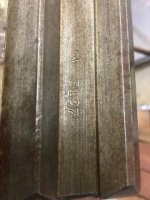We have an old SB 10” lathe at the Hawaii Railway Society that has some strange markings on the bed that we would like to decifer. Basically this lathe was surplussed out of the Pearl Harbor naval shipyard machine shop, a loong time ago. New in 1942 and donated to the HRS sometime in the past 30 years. We know the Lathe came from the Pearl Harbor machine shop, but all the records of its war service disappeared long ago. Hoping someone on PM might know what the stampings indicate.
Here’s some identifying info:
Model: SB 10L - 3 1/2’ bed, with taper attachment. Motor and belt drive mounted in the cabinet, below the headstock
Catalog number : 8187Z
SN: 135111.
Now the unusual USN stampings include the Navy Anchor insignia, and the abbreviations L.O.R. and W.E.F. on the way, just to the right of the SB SN. Also “MA E127” shows on the right rear flat portion of the bed. Wondering if MA stands for a Marine Corp inventory number?
I’ve attached a couple of photos showing the lathe and markings in its current condition. Still doing yeoman service, although finishing its days in our RR museum backshops at Ewa Beach.
As we are an interpretive museum, anything we might find out about the lathes war service would enhance its interpretive value as a working machine tool.
Thanks much for any thoughts you all might have.
View attachment 278587View attachment 278588View attachment 278589
Glenn
Glenn,
I also posted this on the
[email protected] for you. The lathe was shipped in 1943.
Copy of old post on the subject:
In the serial number file, which I am always several years behind on, I only
list the information I am provided with. The posts with my personal opinions
are also kind of old when we were first chatting about the stamps. My
opinions are subject to change…lol, and I have flipped flopped somewhat on
this subject in regards to the JAN stamp, which would/could appear to be a
military spec stamp. Inspectors at the military arms or provision suppliers,
used their initials. The inspectors could be military or military employed
civilian, not important, the point is they are inspection and acceptance
stamps. See info below.
It is well known that SBL was a major machine supplier with the Navy.
Listed Inspection stamps found on SBL machines:
AROTUL USA, DPC 10
DWW, JFP
D.W.W, W.E.F
D.W.W. , F.W.M
D.W.W & J.F.P. U.S.N. Property
D.W.W. , J.F.P. USA-HEW, Defense Plant Corporation tags for Boeing Corp
D.W.W., US, navy stamp (ANCHOR)
D.W.W., D.R.M, US, navy stamp (ANCHOR)
FWM
JAN
JAN, JOD
JBL
J.B.R
JFP
JFP, DWW
JFP, LOR & Flaming Bomb
LQR
LOR, JAN
LOR, JOD
L.O.R., J.F.N., US, navy stamp (ANCHOR)
LOR, JFP
WEF
WBL, DETRO DPC T 505
US 47, J.A.N
Property of USAF 875747
Web search Info found on Inspector stamps:
For Sale: Oficial U.S. Navy inspector's hammer with dies at each end. The
large die is 1 3/16" W x 1 6/16" H. The small die is 9/16" W x 9/16" H. The
mark stamped on an item indicated it has passed inspection.
It is reported by companies that made these items during WW II, that the
inspectors kept these tools under lock and key, and that they never had
access to them. At the end of the War, when the inspectors left the plants,
this tool went with them
JAN = joint Army-Navy [specification]
Inspection and acceptance marks:
The US Navy 'Anchor' stamp indicated the item had been inspected and
accepted by the US Navy.
The U.S. Navy's inspector's mark -- the initials "U S" with a small anchor
between
Small arms of the United States Army and Navy bear an initial or initials
which are called inspector’s marks. These marks appear on stocks, grips or
metal parts. Some arms, especially older ones, have more than one inspector’s
initial or initials.
The Army and Navy purchased arms from commercial outlets and also contracted
directly with the manufacturers. The Navy also purchased some arms from the
Army. From the early days of 1831, most small arms contract inspectors were
civilians or Springfield Armory employees. Officers who served as inspectors
were from the Army Ordnance Department or the Navy Bureau of Ordnance. There
were also sub-inspectors who had regular jobs at Springfield Armory, and
small arms inspection was in addition to their regular duties. Army or Navy
inspectors had control over all sub-inspectors.
It must be noted that in some cases, these inspectors are civilian
personnel. Others will be military personnel
Initials Name, Title Period
SPS Sidney P. Spaulding, Lt. Col., USA- 1940
RS Robert Sears, Col., USA- 1940-45
MS Maurice Sherman, Armory S-l- 1940
LAS Laurence A. Stone, Lt., USA- 1940
GHS Gilbert H. Stewart, Col., USA- 1938-40
CES Clarence E. Simpson, Armory S-l- 1939
ECP Edward C. Perry, Armor) S-l- 1937-40
WCO Warren C. Odell, Armory S-l- 1939
RSJ Robert S. Johnson, Armory S-l- 1940
SLG Sidney L. Gibson, Lt., USA- 1941
SGG Samuel G. Green, Lt. Col., USA- 1939
JKC John K. Christmas, Lt. Col., USA- 1942
JJC John J. Callahan, Armory S-l- 1940
AC Alexander Cameron, Armory S-l-940
WAB William A. Borden, Lt. Col., USA 1936-39
WB Waldemar Broberg, Col., USA- 1941
JAB John A. Brooks, Jr.., Lt. Col., USA- 1940
FJA Frank 1. Atwood, Lt. Col., USA- 1943-45
Steve Wells
The SBL Workshop
The SBL Workshop








